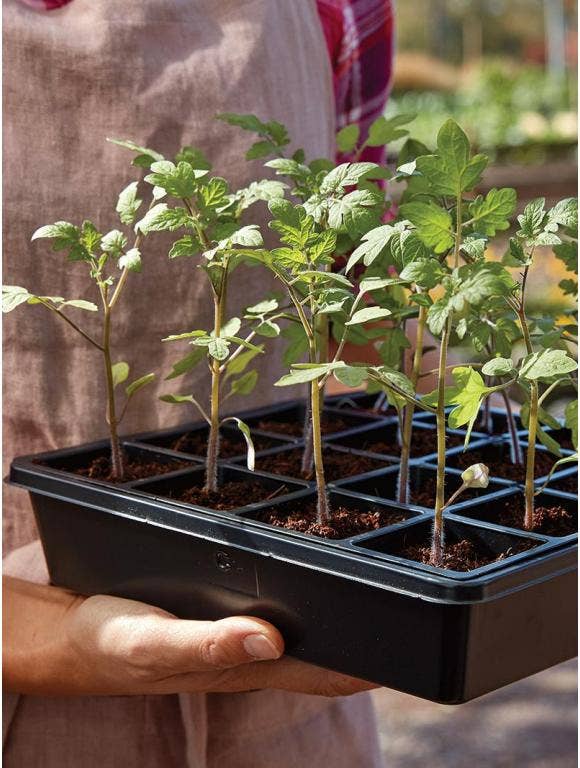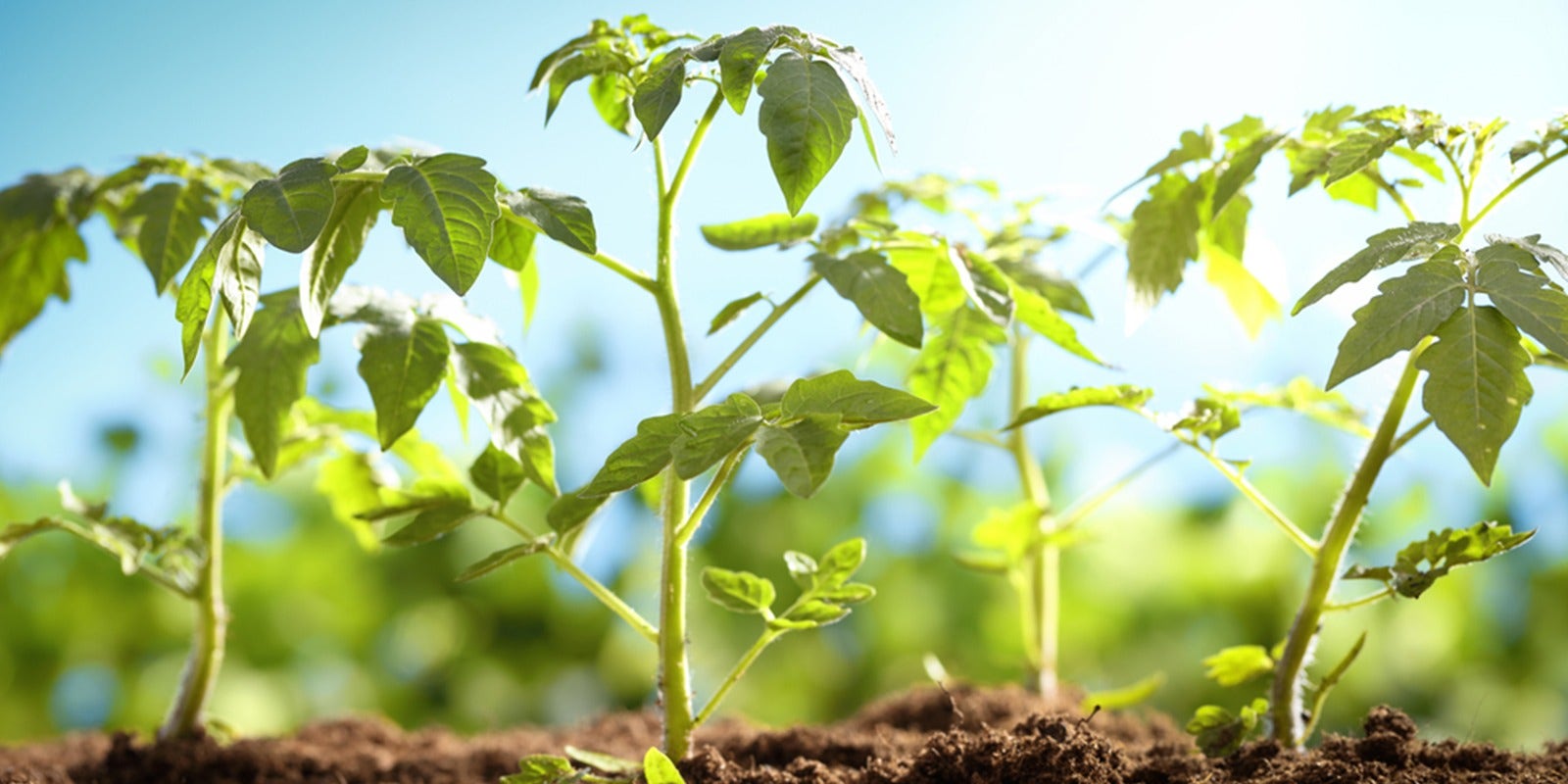
There's a solid chance you got into gardening for the flowers, fruits, veggies and foliage. But as the undersung heroes of the plant world, stems and roots play a supporting role — quite literally — in helping your greens perform their best. The key to growing a healthy plant is providing the right growing conditions. Each plant is slightly different, so remember to check the seed packet or plant tag to determine the basic needs of your plants. Luckily, there are several easy ways to bolster your plants from top to bottom.
Why Strong Stems and Roots Matter
While flashy fruits and bold blooms get all the glory, none of it would be possible without healthy, hardworking roots and stems. One thing that is vital for healthy stems and roots is the soil. The structure of your soil impacts how much water and nutrients will be absorbed by the roots. Soils with high amounts of clay will hold more water and nutrients, while sandy soils tend to lose water and nutrients quickly. Healthy soil improves the growth of roots, which leads to vigorous plants.
If your plants are struggling, consider fertilizing them to provide a boost of nutrients. And for long term success, amend your soil each year with organic matter, such as compost.
Let's look at the function of stems and roots and learn how they can make your plants the total package.
Stems: The Ultimate Support System
Stems are the essential support structures for leaves, flowers and fruits. While the stems of most plants are above ground, some plants have underground stems, like potatoes. Another function of stems is their vascular system, which serves as a highway for water and nutrients to travel from the roots into the rest of the plant. Stems also transport the sugars created in photosynthesis from the leaves to other parts of the plant.
One thing that impacts the health of a stem is sunlight. Plants that are given lots of sunlight develop short and thick stems, while plants in more shade tend to have tall, leggy stems with less branching. For some plants, less sunlight is preferred, while others need plenty of sun to develop a strong and healthy stem. Stems can be soft and small, like those on a delicate flower, or woody and solid like a tree trunk.
If your garden is hot, dry or windy, take note: A strong stem makes it less likely for a plant to topple over in high winds or wither in hot weather. Plus, the taller the stem grows, the more sunlight the plant can take in.
Roots: The Anchor Every Plant Needs
You probably think of roots' primary role as absorbing nutrients and water from the soil, but there's much more happening below the surface. Roots also help affix your plant to the ground, so it holds steady during inclement weather. And, for root vegetables such as beets, carrots and radishes, the root (aka the part you eat) acts as a storage unit for the plant, harboring extra food and moisture for future use.


How to Make Plant Stems Stronger
Overall, good plant care equals good stem care. However, pay special attention to the following factors to help lengthen and strengthen your plants' support system.
- Provide the proper amount of sunlight. Without the right sunlight, your stems will become long and spindly as they try to grow upward to catch more rays. Consult your plant tag or seed packet for how much sun your plant prefers.
- Don't let plants become parched. Too-dry soil prevents stems (and, as a result, entire plants) from absorbing the nutrients they need to grow strong.
- Give them space. When you overcrowd plants, they compete for sunlight, and the tallest will take the lion's share, leaving the shorter ones stuck in the shade.
- Take care in extreme temperatures. Excessive heat can cause plants' stems to undergo a growth spurt where the stem outpaces the leaves and becomes thin and weak. To keep your stems strong, protect plants with floating row covers and offer extra H2O.
- Go next-level with nitrogen. Nitrogen (whose percentage is listed as the first of three numbers on a bag of fertilizer) offers optimal support for stems and leaves.Apply a nitrogen boost by side-dressing (putting fertilizer next to your plants) according to package directions as the growing season progresses. But take note: Nitrogen can be too much of a good thing when it comes to produce. If you overapply, your plant may put too much energy into growing stems and foliage at the expense of fruits and veggies.
How to Strengthen Plant Roots
Similar to stems, a solid plant care routine will go a long way toward strong roots. But if you want to make sure they're as healthy as can be, follow these tips.
- Ensure you have optimal soil. Healthy roots need good drainage and plenty of nutrients to perform their best. Sandy soil will wick away water before roots can absorb it, while heavy clay soil can lead to waterlogging and root rot. Your best bet for well-balanced soil? Compost. Till or rake compost into the top few inches of soil before planting.
- Water deeper but less often. When you water too frequently, roots don't have to exert much effort to absorb moisture. Think of less-frequent waterings like strength training for roots: It encourages them to grow downward to seek H2O, which anchors your plant more securely to the soil. Of course, you don't want to create Sahara-like conditions that stress your plant out — just opt for watering once or twice a week versus daily.
- Watch out when weeding. While every gardener knows that weeding can feel akin to a therapy session, it's essential to mind your roots when tackling garden invaders. A serious tug too close to your plants' roots can move, damage or break them, making them less able to do their critical jobs.
- Hit up a complete fertilizer. Complete fertilizers contain all the nutrients that plants need for healthy stems and root systems including potassium, which promotes root growth and thicker cell walls. Apply per package directions.
Think of roots and stems like the foundation and framing of your house. If either is weak, the rest of your plant may fail to absorb the water and nutrients it needs to reach its full potential. However, with some strategic plant care, you can grow strong stems and vigorous roots that help produce vibrant flowers, juicy produce and lush foliage
There's a solid chance you got into gardening for the flowers, fruits, veggies and foliage. But as the undersung heroes of the plant world, stems and roots play a supporting role — quite literally — in helping your greens perform their best. Luckily, there are several easy ways to bolster your plants from top to bottom. Learn how to make plant stems stronger and how to strengthen plant roots so you can have the healthiest, most vibrant garden possible.
Why Strong Stems and Roots Matter
While flashy fruits and bold blooms get all the glory, none of it would be possible without healthy, hardworking roots and stems. Let's look at what each part does and how it helps transform your plants into the total package.
Stems: The Ultimate Support System
Stems are the essential support structures for leaves, flowers and fruits. Their vascular system serves as a highway for water and nutrients to travel from the roots into the rest of the plant. Stems can be soft and small, like those on a delicate flower, or woody and solid like a tree trunk.
If your garden is hot, dry or windy, take note: A strong stem makes it less likely for a plant to topple over in high winds or wither in hot weather. Plus, the taller the stem grows, the more sunlight the plant can take in.
Roots: The Anchor Every Plant Needs
You probably think of roots' primary role as absorbing nutrients and water from the soil, but there's much more happening below the surface. Roots also help affix your plant to the ground, so it holds steady during inclement weather. And, for root vegetables such as beets, carrots and radishes, the root (aka the part you eat) acts as a storage unit for the plant, harboring extra food and moisture for future use.
How to Make Plant Stems Stronger
Overall, good plant care equals good stem care. However, pay special attention to the following factors to help lengthen and strengthen your plants' support system.
Provide the proper amount of sunlight. Without the right sunlight, your stems will become long and spindly as they try to grow upward to catch more rays. Consult your plant tag or seed packet for how much sun your plant prefers.
Don't let plants become parched. Too-dry soil prevents stems (and, as a result, entire plants) from absorbing the nutrients they need to grow strong.
Give them space. When you overcrowd plants, they compete for sunlight, and the tallest will take the lion's share, leaving the shorter ones stuck in the shade.
Take care in extreme temperatures. Excessive heat can cause plants' stems to undergo a growth spurt where the stem outpaces the leaves and becomes thin and weak. To keep your stems strong, protect plants with floating row covers and offer extra H2O.
Go next-level with nitrogen. Nitrogen (whose percentage is listed as the first of three numbers on a bag of fertilizer) offers optimal support for stems and leaves. Apply a nitrogen boost by side-dressing (putting fertilizer next to your plants) according to package directions as the growing season progresses. But take note: Nitrogen can be too much of a good thing when it comes to produce. If you overapply, your plant may put too much energy into growing stems and foliage at the expense of fruits and veggies.
How to Strengthen Plant Roots
Similar to stems, a solid plant care routine will go a long way toward strong roots. But if you want to make sure they're as healthy as can be, follow these tips.
Ensure you have optimal soil. Healthy roots need good drainage and plenty of nutrients to perform their best. Sandy soil will wick away water before roots can absorb it, while heavy clay soil can lead to waterlogging and root rot. Your best bet for well-balanced soil? Compost. Till or rake compost into the top few inches of soil before planting.
Water deeper but less often. When you water too frequently, roots don't have to exert much effort to absorb moisture. Think of less-frequent waterings like strength training for roots: It encourages them to grow downward to seek H2O, which anchors your plant more securely to the soil. Of course, you don't want to create Sahara-like conditions that stress your plant out — just opt for watering once or twice a week versus daily.
Watch out when weeding. While every gardener knows that weeding can feel akin to a therapy session, it's essential to mind your roots when tackling garden invaders. A serious tug too close to your plants' roots can move, damage or break them, making them less able to do their critical jobs.
Hit up a complete fertilizer. Complete fertilizers contain all the nutrients that plants need for healthy stems and root systems including potassium, which promotes root growth and thicker cell walls. Apply per package directions.
Think of roots and stems like the foundation and framing of your house. If either is weak, the rest of your plant may fail to absorb the water and nutrients it needs to reach its full potential. However, with some strategic plant care, you can grow strong stems and vigorous roots that help produce vibrant flowers, juicy produce and lush foliage.
If you're looking to further strengthen stems and roots, check out Burpee's all-purpose plant food.



